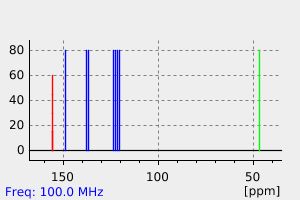6-(chloromethyl)-2,2'-bipyridine | 82740-65-6
中文名称
——
中文别名
——
英文名称
6-(chloromethyl)-2,2'-bipyridine
英文别名
6-(chloromethyl)-2,2’-bipyridine;2,2'-Bipyridine, 6-(chloromethyl)-;2-(chloromethyl)-6-pyridin-2-ylpyridine
CAS
82740-65-6
化学式
C11H9ClN2
mdl
——
分子量
204.659
InChiKey
XYWATVAUJZDUDW-UHFFFAOYSA-N
BEILSTEIN
——
EINECS
——
-
物化性质
-
计算性质
-
ADMET
-
安全信息
-
SDS
-
制备方法与用途
-
上下游信息
-
文献信息
-
表征谱图
-
同类化合物
-
相关功能分类
-
相关结构分类
计算性质
-
辛醇/水分配系数(LogP):1.9
-
重原子数:14
-
可旋转键数:2
-
环数:2.0
-
sp3杂化的碳原子比例:0.09
-
拓扑面积:25.8
-
氢给体数:0
-
氢受体数:2
上下游信息
-
上游原料
中文名称 英文名称 CAS号 化学式 分子量 6-甲基-2,2′-二吡啶 6-methyl-2,2'-bipyridine 56100-22-2 C11H10N2 170.214 6-氰基-2,2'-联吡啶 2,2'-bipyridyl-6-carbonitrile 4392-85-2 C11H7N3 181.197 [2,2-联吡啶]-6-甲醛 6-formyl-2,2'-bipyridine 134296-07-4 C11H8N2O 184.197 —— 6-(hydroxymethyl)-2,2'-bipyridine 149775-41-7 C11H10N2O 186.213 —— 6’-[(trimethylsilyl)methyl]-2’,2-bipyridine 219944-91-9 C14H18N2Si 242.396 2,2'-联吡啶-6-甲酸甲酯 2,2'-dipyridyl-6-carboximidic acid methyl ester 203573-76-6 C12H10N2O2 214.224 2,2'-联吡啶 [2,2]bipyridinyl 366-18-7 C10H8N2 156.187 4-甲基-2,2-联吡啶 4-methyl-2,2'-bipyridine 56100-19-7 C11H10N2 170.214 -
下游产品
中文名称 英文名称 CAS号 化学式 分子量 —— 2-(6-Pyridin-2-ylpyridin-2-yl)acetonitrile 203573-77-7 C12H9N3 195.224 —— 1,3-bis([2,2'-bipyridin]-6-ylmethoxy)propane 1352034-64-0 C25H24N4O2 412.491 —— 6,6''-(((2,2-dimethylpropane-1,3-diyl)bis(oxy))bis(methylene))di-2,2'-bipyridine 1352034-65-1 C27H28N4O2 440.545 —— 1-([2,2'-bipyridin]-6-yl)-N,N-bis(pyridin-2-ylmethyl)methanamine 1339945-49-1 C23H21N5 367.453 —— 6-((di-isopropylphosphino)methyl)-2,2'-bipyridine 1373719-22-2 C17H23N2P 286.357 —— 7,16-Bis(2,2'-bipyridin-6-ylmethyl)-1,4,10,13-tetraoxa-7,16-diazacyclooctadecane 144809-29-0 C34H42N6O4 598.745 —— 6-((diphenylphosphino)methyl)-2,2'-bipyridine 1373719-31-3 C23H19N2P 354.391
反应信息
-
作为反应物:描述:参考文献:名称:铁(II)双(吡啶基)胺-联吡啶骨架用于选择性 CO2 光还原的机理洞察摘要:据报道,即使在 1% CO 2下,聚吡啶铁基骨架也可用于选择性 CO 2到 CO 的光还原。机理见解揭示了两个连续的单电子转移,在 Fe 和配体上为 CO 2添加提供了具有离域电子密度的中间体。质子辅助的 CO 形成对于 CO 2还原至关重要。悬垂的质子穿梭 α-OH 基团专门将转化转换为 H 2,从而能够在灵活的 CO/H 2比率下形成自分选合成气。DOI:10.1002/anie.202107386
-
作为产物:描述:6-氰基-2,2'-联吡啶 在 盐酸 、 sodium tetrahydroborate 、 氯化亚砜 、 硫酸 作用下, 反应 40.0h, 生成 6-(chloromethyl)-2,2'-bipyridine参考文献:名称:Regioselective Functionalization of 2,2'-Bipyridine and Transformations into Unsymmetric Ligands for Coordination Chemistry.摘要:Novel synthetic strategies for a series of unsymmetrically substituted 2,2'-bipyridines have been developed. These bipyridines have found use in some novel homoleptic and heteroleptic ruthenium(II) complexes. Two methods for regiochemical control of nucleophilic addition to bpy have been explored: (i) mono N-oxidation followed by cyanation and subsequent hydrolysis gave 6-carboxy-2,2'-bipyridine (4); (ii) mono N-methylation followed by the conversion into 6-bromo-2,2'-bipyridine (12) and subsequent nucleophilic addition of lithio-acetonitrile followed by hydrolysis of 6-cyanomethyl-2,2'-bipyridine (8) gave the homologous 2,2'-bipyridine-6-acetic acid (9). An established method of regioselective mono-ring alkylation of bpy using methyllithium yielded 6-methyl-2,2'-bipyridine (14), and the generation of the anion of 14 and subsequent addition to a chloromethyl oxazoline was applied to synthesize a second homologue, methyl 2,2'-bipyridine-6-propanoate (16). Structural determinations using H-1, C-13 and 2D NMR spectroscopy permitted complete assignments of all signals in the H-1 NMR spectra.DOI:10.3891/acta.chem.scand.52-0077
文献信息
-
Conformationally Switchable Glycosyl Donors作者:Thomas Holmstrøm、Christian Marcus PedersenDOI:10.1021/acs.joc.9b00830日期:2019.11.1Glycosyl donors functionalized with 2,2'-bipyridine moieties on the 3-OH and 6-OH or the 2-OH and 4-OH undergo a conformational change when forming 1:1 complexes with Zn2+ ions. The pyranoside ring of the zinc complexes adopted axial-rich skew boat conformations. The reactivities of the two glycosyl donors were investigated by performing a series of glycosylations in the presence or absence of Zn2+
-
Formation of Tertiary Amides and Dihydrogen by Dehydrogenative Coupling of Primary Alcohols with Secondary Amines Catalyzed by Ruthenium Bipyridine-Based Pincer Complexes作者:Dipankar Srimani、Ekambaram Balaraman、Peng Hu、Yehoshoa Ben-David、David MilsteinDOI:10.1002/adsc.201300620日期:2013.9.16Dehydrogenative coupling of primary alcohols with secondary amines to form tertiary amides and dihydrogen (H2) is efficiently catalyzed by bipyridyl‐based ruthenium pincer complexes (0.2–1 mol%) under neutral conditions (in case of the dearomatized complexes), or with added catalytic amount of base. The reaction is sensitive to steric hindrance; in the case of amidation of bulky secondary amines a
-
Direct Hydrogenation of Amides to Alcohols and Amines under Mild Conditions作者:Ekambaram Balaraman、Boopathy Gnanaprakasam、Linda J. W. Shimon、David MilsteinDOI:10.1021/ja1080019日期:2010.12.1The selective, direct hydrogenation of amides to the corresponding alcohols and amines with cleavage of the C-N bond was discovered. The expected products of C-O cleavage are not formed (except as traces in the case of anilides). The reaction proceeds under mild pressure and neutral, homogeneous conditions using a dearomatized, bipyridyl-based PNN Ru(II) pincer complex as a catalyst. The postulated
-
Optically Active Helical Lanthanide Complexes: Storable Chiral Lewis Acidic Catalysts for Enantioselective Diels–Alder Reaction of Siloxydienes作者:Shinji Harada、Saki Nakashima、Shihori Sekino、Wakana Oishi、Atsushi NishidaDOI:10.1002/asia.201901705日期:2020.2.17Lanthanide triflates and a series of hexadentate chiral ligand complexes were synthesized. X‐ray‐quality crystals were obtained from mixtures of the lanthanide complexes, which were helical in shape. The complexes showed Lewis acidity and catalyzed the enantioselective Diels–Alder reaction of electron‐rich siloxydienes. The complexes were stable enough to be stored at ambient temperature on a laboratory
-
Unidirectional Photo-induced Charge Separation and Thermal Charge Recombination of Cofacially Aligned Donor-Acceptor System Probed by Ultrafast Visible-Pump/Mid-IR-Probe Spectroscopy作者:Hyeong-Mook Kim、Jaeheung Park、Hee Chang Noh、Manho Lim、Young Keun Chung、Youn K. KangDOI:10.5012/bkcs.2014.35.2.587日期:2014.2.20A new
$\pi}$ -stacked donor-acceptor (D-A) system, [Ru(1-([2,2'-bipyridine]-6-yl-methyl)-3-(2-cyclohexa-2',5'-diene-1,4-dionyl)-1H-imidazole)(2,2':6',2"-terpyridine)]$[PF_6 ] _2$ (ImQ_T), has been synthesized and characterized. Similar to its precedent, [Ru(6-(2-cyclohexa-2',5'-diene-1,4-dione)-2,2':6',2"-terpyridine)(2,2':6',2"-terpyridine)]$[PF_6 ] _2$ (TQ_T), this system has a cofacial alignment of terpyridine (tpy) ligand and quinonyl (Q) group, which facilitates an electron transfer through$\pi}$ -stacked manifold. Despite the presence of lowest-energy charge transfer transition from the Ru-based-HOMO-to-Q-based-LUMO (MQCT) predicted by theoretical calculations by using time-dependent density functional theory (TD-DFT), the experimental steady-state absorption spectrum does not exhibit such a band. The selective excitation to the Ru-based occupied orbitals-to-tpy-based virtual orbital MLCT state was thus possible, from which charge separation (CS) reaction occurred. The photo-induced CS and thermal charge recombination (CR) reactions were probed by using ultrafast visible-pump/mid-IR-probe (TrIR) spectroscopic method. Analysis of decay kinetics of Q and$Q^-$ state CO stretching modes as well as aromatic C=C stretching mode of tpy ligand gave time constants of <1 ps for CS, 1-3 ps for CR, and 10-20 ps for vibrational cooling processes. The electron transfer pathway was revealed to be Ru-tpy-Q rather than Ru-bpy-imidazol-Q.合成并表征了一种新的$\pi}$ -堆叠的供体-受体 (D-A) 系统,[Ru(1-([2,2'-联吡啶]-6-基甲基)-3-(2-环己烯-2',5'-二酮)-1H-咪唑)(2,2':6',2"-联吡啶)]$[PF_6] _2$ (ImQ_T)。与其前体 [Ru(6-(2-环己烯-2',5'-二酮)-2,2':6',2"-联吡啶)(2,2':6',2"-联吡啶)]$[PF_6] _2$ (TQ_T) 类似,该系统具有共面排列的联吡啶 (tpy) 配体和醌基 (Q) 基团,这促进了通过$\pi}$ -堆叠结构的电子转移。尽管理论计算通过时间依赖密度泛函理论 (TD-DFT) 预测了从基于铑的最高占据分子轨道 (HOMO) 到基于醌的最低未占据分子轨道 (LUMO) 的最低能量电荷转移跃迁 (MQCT) 的存在,但实验的稳态吸收光谱并未观察到此类带。因此,选择性激发到基于铑的占据轨道与基于 tpy 的虚拟轨道的 MLCT 态成为可能,从中发生了电荷分离 (CS) 反应。通过超快可见光泵浦/中红外探头 (TrIR) 光谱方法探测了光诱导的 CS 和热电荷复合 (CR) 反应。对 Q 和$Q^-$ 态的 CO 切伸模式以及 tpy 配体的芳香 C=C 切伸模式的衰减动力学分析给出了 CS 的时间常数小于 1 ps,CR 为 1-3 ps,振动冷却过程为 10-20 ps。电子转移路径显示为 Ru-tpy-Q,而非 Ru-bpy-imidazol-Q。
表征谱图
-
氢谱1HNMR
-
质谱MS
-
碳谱13CNMR
-
红外IR
-
拉曼Raman
-
峰位数据
-
峰位匹配
-
表征信息
同类化合物
(S)-氨氯地平-d4
(R,S)-可替宁N-氧化物-甲基-d3
(R)-(+)-2,2'',6,6''-四甲氧基-4,4''-双(二苯基膦基)-3,3''-联吡啶(1,5-环辛二烯)铑(I)四氟硼酸盐
(R)-N'-亚硝基尼古丁
(R)-DRF053二盐酸盐
(5E)-5-[(2,5-二甲基-1-吡啶-3-基-吡咯-3-基)亚甲基]-2-亚磺酰基-1,3-噻唑烷-4-酮
(5-溴-3-吡啶基)[4-(1-吡咯烷基)-1-哌啶基]甲酮
(5-氨基-6-氰基-7-甲基[1,2]噻唑并[4,5-b]吡啶-3-甲酰胺)
(2S,2'S)-(-)-[N,N'-双(2-吡啶基甲基]-2,2'-联吡咯烷双(乙腈)铁(II)六氟锑酸盐
(2S)-2-[[[9-丙-2-基-6-[(4-吡啶-2-基苯基)甲基氨基]嘌呤-2-基]氨基]丁-1-醇
(2R,2''R)-(+)-[N,N''-双(2-吡啶基甲基)]-2,2''-联吡咯烷四盐酸盐
(1'R,2'S)-尼古丁1,1'-Di-N-氧化物
黄色素-37
麦斯明-D4
麦司明
麝香吡啶
鲁非罗尼
鲁卡他胺
高氯酸N-甲基甲基吡啶正离子
高氯酸,吡啶
高奎宁酸
马来酸溴苯那敏
马来酸氯苯那敏-D6
马来酸左氨氯地平
顺式-双(异硫氰基)(2,2'-联吡啶基-4,4'-二羧基)(4,4'-二-壬基-2'-联吡啶基)钌(II)
顺式-二氯二(4-氯吡啶)铂
顺式-二(2,2'-联吡啶)二氯铬氯化物
顺式-1-(4-甲氧基苄基)-3-羟基-5-(3-吡啶)-2-吡咯烷酮
顺-双(2,2-二吡啶)二氯化钌(II) 水合物
顺-双(2,2'-二吡啶基)二氯化钌(II)二水合物
顺-二氯二(吡啶)铂(II)
顺-二(2,2'-联吡啶)二氯化钌(II)二水合物
韦德伊斯试剂
非那吡啶
非洛地平杂质C
非洛地平
非戈替尼
非布索坦杂质66
非尼拉朵
非尼拉敏
雷索替丁
阿雷地平
阿瑞洛莫
阿扎那韦中间体
阿培利司N-6
阿伐曲波帕杂质40
间硝苯地平
间-硝苯地平
镉,二碘四(4-甲基吡啶)-
锌,二溴二[4-吡啶羧硫代酸(2-吡啶基亚甲基)酰肼]-







